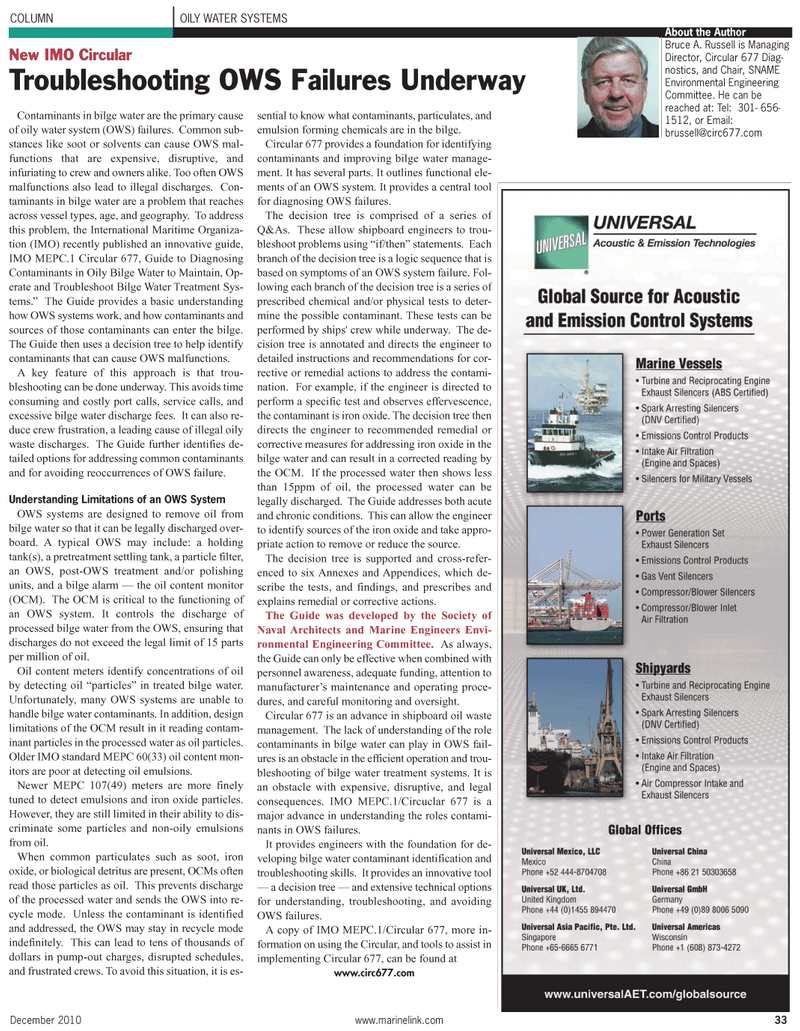
Page 33: of Maritime Reporter Magazine (December 2010)
Great Ships of 2010
Read this page in Pdf, Flash or Html5 edition of December 2010 Maritime Reporter Magazine
December 2010 www.marinelink.com 33
Contaminants in bilge water are the primary cause of oily water system (OWS) failures. Common sub- stances like soot or solvents can cause OWS mal- functions that are expensive, disruptive, and infuriating to crew and owners alike. Too often OWS malfunctions also lead to illegal discharges. Con- taminants in bilge water are a problem that reaches across vessel types, age, and geography. To address this problem, the International Maritime Organiza- tion (IMO) recently published an innovative guide,
IMO MEPC.1 Circular 677, Guide to Diagnosing
Contaminants in Oily Bilge Water to Maintain, Op- erate and Troubleshoot Bilge Water Treatment Sys- tems.” The Guide provides a basic understanding how OWS systems work, and how contaminants and sources of those contaminants can enter the bilge.
The Guide then uses a decision tree to help identify contaminants that can cause OWS malfunctions.
A key feature of this approach is that trou- bleshooting can be done underway. This avoids time consuming and costly port calls, service calls, and excessive bilge water discharge fees. It can also re- duce crew frustration, a leading cause of illegal oily waste discharges. The Guide further identifies de- tailed options for addressing common contaminants and for avoiding reoccurrences of OWS failure.
Understanding Limitations of an OWS System
OWS systems are designed to remove oil from bilge water so that it can be legally discharged over- board. A typical OWS may include: a holding tank(s), a pretreatment settling tank, a particle filter, an OWS, post-OWS treatment and/or polishing units, and a bilge alarm — the oil content monitor (OCM). The OCM is critical to the functioning of an OWS system. It controls the discharge of processed bilge water from the OWS, ensuring that discharges do not exceed the legal limit of 15 parts per million of oil.
Oil content meters identify concentrations of oil by detecting oil “particles” in treated bilge water.
Unfortunately, many OWS systems are unable to handle bilge water contaminants. In addition, design limitations of the OCM result in it reading contam- inant particles in the processed water as oil particles.
Older IMO standard MEPC 60(33) oil content mon- itors are poor at detecting oil emulsions.
Newer MEPC 107(49) meters are more finely tuned to detect emulsions and iron oxide particles.
However, they are still limited in their ability to dis- criminate some particles and non-oily emulsions from oil.
When common particulates such as soot, iron oxide, or biological detritus are present, OCMs often read those particles as oil. This prevents discharge of the processed water and sends the OWS into re- cycle mode. Unless the contaminant is identified and addressed, the OWS may stay in recycle mode indefinitely. This can lead to tens of thousands of dollars in pump-out charges, disrupted schedules, and frustrated crews. To avoid this situation, it is es- sential to know what contaminants, particulates, and emulsion forming chemicals are in the bilge.
Circular 677 provides a foundation for identifying contaminants and improving bilge water manage- ment. It has several parts. It outlines functional ele- ments of an OWS system. It provides a central tool for diagnosing OWS failures.
The decision tree is comprised of a series of
Q&As. These allow shipboard engineers to trou- bleshoot problems using “if/then” statements. Each branch of the decision tree is a logic sequence that is based on symptoms of an OWS system failure. Fol- lowing each branch of the decision tree is a series of prescribed chemical and/or physical tests to deter- mine the possible contaminant. These tests can be performed by ships' crew while underway. The de- cision tree is annotated and directs the engineer to detailed instructions and recommendations for cor- rective or remedial actions to address the contami- nation. For example, if the engineer is directed to perform a specific test and observes effervescence, the contaminant is iron oxide. The decision tree then directs the engineer to recommended remedial or corrective measures for addressing iron oxide in the bilge water and can result in a corrected reading by the OCM. If the processed water then shows less than 15ppm of oil, the processed water can be legally discharged. The Guide addresses both acute and chronic conditions. This can allow the engineer to identify sources of the iron oxide and take appro- priate action to remove or reduce the source.
The decision tree is supported and cross-refer- enced to six Annexes and Appendices, which de- scribe the tests, and findings, and prescribes and explains remedial or corrective actions.
The Guide was developed by the Society of
Naval Architects and Marine Engineers Envi- ronmental Engineering Committee. As always, the Guide can only be effective when combined with personnel awareness, adequate funding, attention to manufacturer’s maintenance and operating proce- dures, and careful monitoring and oversight.
Circular 677 is an advance in shipboard oil waste management. The lack of understanding of the role contaminants in bilge water can play in OWS fail- ures is an obstacle in the efficient operation and trou- bleshooting of bilge water treatment systems. It is an obstacle with expensive, disruptive, and legal consequences. IMO MEPC.1/Circuclar 677 is a major advance in understanding the roles contami- nants in OWS failures.
It provides engineers with the foundation for de- veloping bilge water contaminant identification and troubleshooting skills. It provides an innovative tool — a decision tree — and extensive technical options for understanding, troubleshooting, and avoiding
OWS failures.
A copy of IMO MEPC.1/Circular 677, more in- formation on using the Circular, and tools to assist in implementing Circular 677, can be found at www.circ677.com
COLUMN OILY WATER SYSTEMS
New IMO Circular
Troubleshooting OWS Failures Underway
About the Author
Bruce A. Russell is Managing
Director, Circular 677 Diag- nostics, and Chair, SNAME
Environmental Engineering
Committee. He can be reached at: Tel: 301- 656- 1512, or Email: [email protected]

 32
32

 34
34
